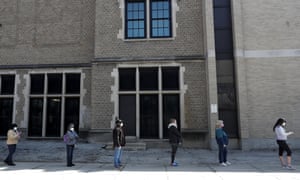White House coronavirus response coordinator says there is cautious optimism that the country can defeat projected death tolls

Photograph: Morry Gash/AP
Social distancing and other mitigation efforts by the American people are working, raising hopes that the US can defy projected death tolls, the White House coronavirus task force said on Wednesday.
The task force projected on 31 March that the pandemic could claim between 100,000 and 240,000 American lives, even if the federal guidelines were maintained, based in part on evidence from Europe. There is now cautious optimism that the final total, while still monumental, will be lower.
Dr Deborah Birx, the response coordinator, told reporters: “We carefully looked at Italy and Spain and we are doing much better in many cases than several other countries and we’re trying to understand that. We believe that our healthcare delivery system in the United States is quite extraordinary.”
One model run by the Institute for Health Metrics and Evaluation at the University of Washington School of Medicine predicts the virus will kill 60,000 people in the US over the next four months – some 33,000 fewer than its estimate last Thursday.
Birx continued: “That is modelled on what America is doing. That’s what’s happening and I think what has been so remarkable to those of us who have been in the science field for so long is how important behavioural change is and how amazing Americans are in adapting to and following through on these behavioural changes.
“And that’s what’s changing the rate of new cases and that’s what will change the mortality going forward because now we’re into the time period of full mitigation that should be reflected within the coming weeks of decreasing mortality. That’s what we really hope to see. We are impressed by the American people.”
The public response will change the way scientists look at respiratory diseases and consider what is possible, Birx added. “We are still in awe, really, of the American people’s strength in this in following through.”
Robert Redfield, director of the Centers for Disease Control and Prevention, added: “This is a consequence of the commitment of the American people … What’s been remarkable to watch here is how the American public has changed their behaviour when it protects the vulnerable.”

And Dr Anthony Fauci, director of the National Institute of Allergy and Infectious Diseases, told the briefing: “Remember, what you do with data will always outstrip a model. You redo your models depending upon your data and our data is telling us that mitigation is working. So again, as Dr Birx said, keep your foot on the accelerator because that’s what’s going to get us through this.”
The task force warned against complacency, however, insisting that the advice must still be followed and warning that moving too soon could result in a “second wave”. After the current guidelines end on 30 April, a battle is looming between cautious public health experts and Trump’s economic team who are eager to restart.
Laura Ingraham, a Fox News host whom Trump name-checked on Tuesday, tweeted: “At some point, the president is going to have to look at Drs. Fauci and Birx and say, we’re opening on May 1. Give me your best guidance on protocols, but we cannot deny our people their basic freedoms any longer.”
At Wednesday’s briefing, Trump sounded bullish about the prospects of getting back to business sooner than some had expected. “Aspirationally, I said let’s see if we can do it at Easter, but I said it would be very tough, and I was criticised for that.
“But I don’t think we’re going to be very far behind and some of these models are looking like Easter’s going to be a very important date anyway because of the curve. It’s hitting the top and it’s starting to come down.”
Trump claimed that Louisiana needs far fewer beds than expected, a makeshift hospital at the Javits Center in New York “isn’t too heavily used” and in general “the numbers are coming way down”. He went on, “I’m not getting called where they need ventilators any more, so we were right on those ventilators” – though he had taken a call from Senator Cory Gardner in Colorado on Tuesday night requesting a hundred.
Such claims are likely to raise fears that Trump is sliding back into complacency, even as states such as New York and New Jersey struggle for ventilators and other equipment. The current US death toll is more than 13,000.
Trump was also asked about reports that US intelligence officials warned as far back as late November that the coronavirus was spreading through China’s Wuhan region and posing a severe threat. He said: “When I learned about the gravity of it was some time just prior to closing the country to China … so I don’t know exactly, but I’d like to see the information.”
The briefing also strayed into absurdity when a reporter asked whether he would consider a pardon for Joe Exotic, who tried to hire a hit man to kill a rival and whose story is told in the hit Netflix series Tiger King. “You think he didn’t do it?” Trump said. “Are you recommending a pardon?” He added: “I’ll take a look.”



